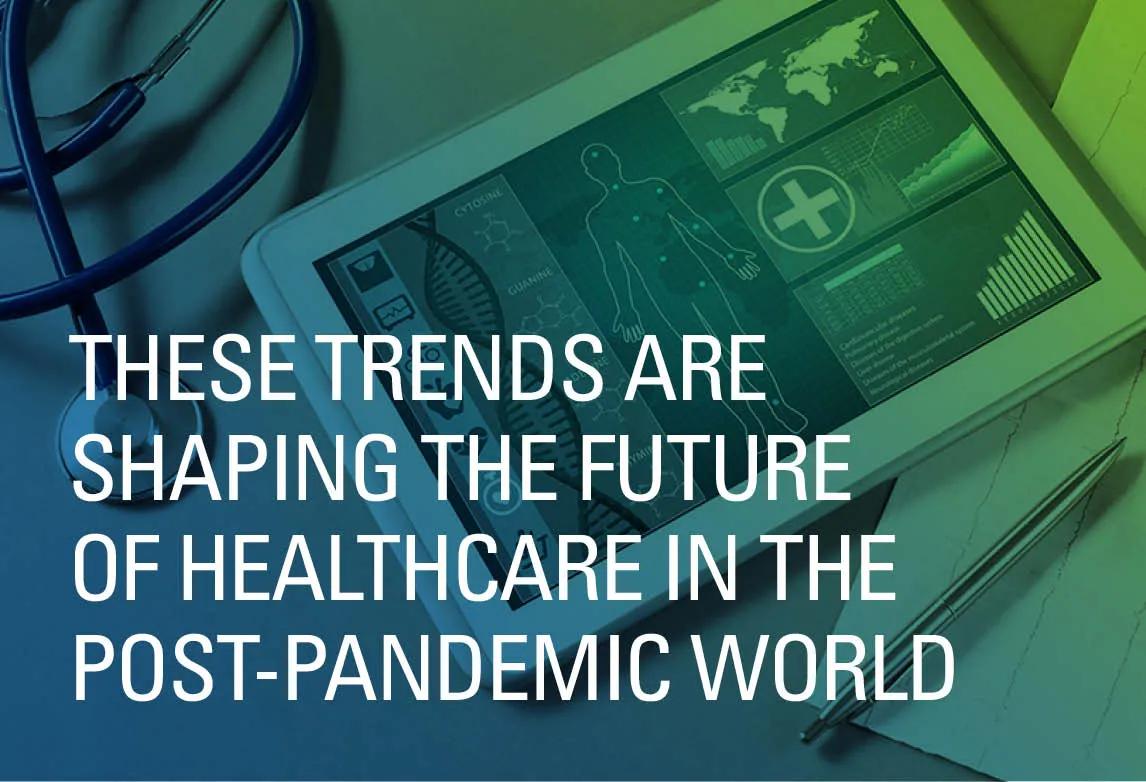These Trends Are Shaping the Future of Healthcare in the Post-Pandemic World

While the pandemic isn’t quite in the rearview mirror, we can begin to understand the larger trends that are impacting the post-pandemic world. Very few, if any, industries were left unscathed from last year’s COVID-19 outbreak, with healthcare, travel, and restaurants being among the most heavily affected. A recent McKinsey study predicts that entertainment, recreation, and food service sectors could take more than five years to fully recover.
By contrast, although burnout is a factor in some health professions like nursing, the healthcare industry as a whole is recovering and expected to grow. In fact, the healthcare industry is projected for 15 percent growth through 2029, according to the U.S. Bureau of Labor Statistics (BLS). Let’s unpack the emerging post-pandemic trends and the implications these will have on the healthcare industry.
Despite the demands of frontline roles, healthcare is still a growing field
Hospitals and health organizations around the world battled the coronavirus last year and have been at the forefront of vaccine distribution and administration in 2021. Even in normal times the nursing field is one that is prone to burnout and last year was no exception as it bore the brunt of the pandemic response. As a result, more COVID-weary health workers exited the field than expected. Despite increased turnover, BLS predicts that the demand for healthcare workers will only grow post-pandemic, adding 2.4 million new jobs by 2029, (faster than average for all occupations) — including the demand for nurses as well. In fact, BLS projects that there will be 175,000 openings for nursing assistants each year for the next nine years.
Nursing salaries remain strong with signing bonuses increasing by 12% during the pandemic, according to healthcare staffing platform, Incredible Health. Hospitals will turn to retention strategies to try to boost job satisfaction in a few areas: support services, staffing levels and advancement.
COVID propelled the growth of telehealth
Prior to the pandemic, not many were opting for virtual medical visits, but 2020 changed that. The use of telehealth exploded during the peak surges of the pandemic, as patients and providers sought the safety and convenience of accessing their medical care remotely. When teleconferencing became the new normal across many industries, extending that to healthcare became more intuitive, especially for those who had the technology capabilities to use it. Last year, consulting firm Frost & Sullivan predicted a ‘tsunami of growth’ for telehealth, projecting that it will grow sevenfold by 2025, a five-year compound annual growth rate of 38.2%.
A study published in the Journal of the American Informatics Association stated that urgent virtual care visits at New York University Langone Health exploded by 683% between March 2 and April 14, 2020, and non-urgent virtual visits by 4,345%. Now that we’re facing a post-pandemic world, consumers may be more willing to give telemedicine a try. This could align well with the needs of an aging population, as the population of 77 million baby boomers will be older than 65 by 2034
Hospitals and health organizations will continue to strategize how virtual care fits into their long-term growth objectives. Remote managed care was particularly effective for those with chronic conditions and for those patients who had COVID but didn’t need hospitalization. Advancements in these areas were further expanded by the outbreak, and hybrid patient care could become part of the norm.
Technology is a priority for health companies
Another pandemic lesson learned is how reliant health systems are on technology. Information technology adoption exploded in 2020 by necessity — virtual care, remote visits, and electronic data communication were the workarounds that kept the health system going. Moving forward, many health organizations are looking to invest in technology innovation so they can provide secure, digitally enabled care over the long term.
Ransomware attacks will prompt added cybersecurity measures
In case battling a pandemic wasn’t enough, six hospitals from coast to coast were hit with ransomware attacks within 24 hours in October last year, shutting down IT systems and stalling vital hospital operations. Even unaffected organizations cut off their external emails in an effort to ward off a potential attack. Health systems recognize the importance of investing in cybersecurity technology and talent in order to defend against these dangerous and sophisticated hacking strikes. Increased cybersecurity attacks in other sectors (retail, energy, banking) will reinforce the importance of safeguarding these vital systems.
Electronic health records (EHR) get enabled software
Your favorite digital assistants like Alexa or Google Home could be coming to hospitals and patient rooms in the near future. And since increased record-sharing needs were tested during the pandemic, health care demands EHRs that are more efficient. EHR vendors like Epic and Cerner are both in discussion to incorporate a virtual assistant into their software. In addition, the federal government deployed new regulations to make it easier for patients to gain control of their health data via smartphone apps while still being able to communicate efficiently between providers and insurance companies.
Artificial Intelligence and data analytics in healthcare
Artificial intelligence (AI) is not a new concept for hospitals but played its most critical role during 2020, when it was deployed for predictive modeling in COVID cases across the country. Health centers like Mount Sinai, Johns Hopkins, Mayo Clinic and UC Irvine developed models that could estimate the risk of COVID patients developing severe symptoms and to help track the virus. It’s expected for these types of predictive tools to be expanded and applied other aspects of medical care.
Advancements in technology and virtual reality
Robotics, artificial intelligence (AI), and virtual reality (VR) had already had a presence in healthcare and that’s a reality that will extend into the post-pandemic world. Robotic surgery advancements will continue to develop into cardiology and spinal surgeries, in addition to oncology. Last October, St. Elizabeth Edgewood Hospital in Kentucky became the first to implant a Bluetooth-connected cardiac defibrillator, which will pair with a smartphone app and can be controlled by the patient. Prior to COVID, virtual reality headsets were just beginning to be used as a clinician training tool. In 2020, several hospitals in London used VR as a way to minimize patient contact and the number of physicians needed to make rounds. Critical care and cardiology centers are also using VR to practice surgical techniques.
In other places, VR is being used to helping practitioners and clinicians with empathy training, teaching them how to experience things from the patient’s perspective. Brandi Yates, Senior Director of Workforce Solutions at Ultimate Medical Academy, has seen the beneficial impact of VR training in her role. “VR is an ideal way to work through delicate work situations in a safe space.” VR is a unique tool that is being used with soft skills training and critical conversations similar to performance evaluations and developmental conversations to name a few. It gives you a safe space to practice challenging and high stakes experiences.”
Last year, UMA featured a “Empathy and Healthcare” VR training module at their 5th annual Spark Summit health partner virtual conference. Participants stepped into virtual pharmacy environments as a pharmacist was troubleshooting a common customer problem — a billing error. “VR is an ideal way to shift into the B2B virtual setting,” explains Yates. In the six-minute training mod, the trainee calls the benefits provider to help resolve the billing problem so that the customer can fill her prescription. “The VR training offers solutions on how to fix the billing error, teaching them how to react to it in the moment, with empathy and problem-solving.” There’s even a self-evaluation that results in a score at the end, and you can keep playing it to improve. Yates notes, “There are so many possibilities for VR as a training tool. It’s been particularly effective at events because, let’s face it, many of us are a little ‘Zoomed-out’ and need a break from the usual training format!”
Yates and her team will be ready to showcase another round of VR soft skills and health training mods later this year at their upcoming Spark Summit conference in September.
Sources:
U.S. Bureau of Labor Statistics. Occupational Outlook Handbook. Healthcare Occupations. https://www.bls.gov/ooh/healthcare/home.htm
U.S. Bureau of Labor Statistics. Occupational Outlook Handbook. Nursing Assistants and Orderlies. bls.gov/ooh/healthcare/nursing-assistants.htm#tab-6
Telehealth set for ‘tsunami of growth’, says Frost & Sullivan. May 15, 2020. https://www.healthcareitnews.com/news/telehealth-set-tsunami-growth-says-frost-sullivan
COVID-19 transforms healthcare through telemedicine: Journal of the American Medical Informatics Association, Volume 27, Issue 7, July 2020, pages 1132-1135. https://academic.oup.com/jamia/article/27/7/1132/5824298?guestAccessKey=3621cf08-b2df-4027-b1f5-7dadadcd640f
Healio Rheumatology. September 25, 2020. https://www.healio.com/news/rheumatology/20200924/growing-patient-preference-ensures-telehealth-is-here-to-stay-beyond-covid19
Census.gov. Older People Projected to Outnumber Children for First Time in U.S. History History. October 8, 2019. https://www.census.gov/newsroom/press-releases/2018/cb18-41-population-projections.html
Washington Post.com. Hospitals being hit in coordinated targeted ransomeware attack from Russian-speaking criminals. Oct. 29, 2020. https://www.washingtonpost.com/national-security/hospitals-being-hit-in-coordinated-targeted-ransomware-attack-from-russian-speaking-criminals/2020/10/28/e6e48c38-196e-11eb-befb-8864259bd2d8_story.html
Becker’s Health IT. 10 emerging trends in health IT for 2021. December 28, 2020. https://www.beckershospitalreview.com/healthcare-information-technology/10-emerging-trends-in-health-it-for-2021.html
Becker’s Health It. Mixed-reality headsets reduce physician contact with COVID-19 patients by 80% at London hospitals. https://www.beckershospitalreview.com/digital-transformation/mixed-reality-headsets-reduce-physician-contact-with-covid-19-patients-by-80-at-london-hospitals.html
Healthcare IT News. Telehealth has staying power, should benefit from lasting regulatory changes. https://www.healthcareitnews.com/news/telehealth-has-staying-power-should-benefit-lasting-regulatory-changes
About the Author
 Tommy Moon
Tommy MoonTommy Moon is the Senior Vice President of Career Services. Since joining Ultimate Medical Academy in 2016, he has overseen the support services that align with the organization’s vision to champion student outcomes, including career placement, externships, registration, certification, employer partnerships, and alumni services.


